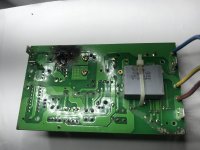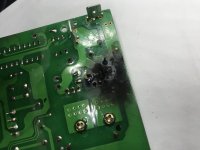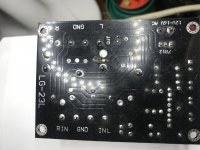G'day Guys,
What causes a perfectly functioning device to spontaneously fail?
Exhibit A:


This is the controller pcb from a commercial blender.
The blender functioned perfectly until it suddenly decided to put out some magic smoke.
To me it appears as though an arc has occurred across the lead of a diode to the lead of a mosfet.
Exhibit B:

This is an Ebay speaker protection board. It worked perfectly the first 5 or so times it was powered up however during a recent test of an amp I was building I saw a little puff of smoke come out and found the melted pcb trace.
What causes a perfectly functioning device to spontaneously fail?
Exhibit A:


This is the controller pcb from a commercial blender.
The blender functioned perfectly until it suddenly decided to put out some magic smoke.
To me it appears as though an arc has occurred across the lead of a diode to the lead of a mosfet.
Exhibit B:

This is an Ebay speaker protection board. It worked perfectly the first 5 or so times it was powered up however during a recent test of an amp I was building I saw a little puff of smoke come out and found the melted pcb trace.
Nothing unusual in either of those in my experience.
It happens. The motor might have arced or flashed over, maybe a dry somewhere dealt a hand... moisture even. Many possible reasons but nothing uncommon.
The eBay board possibly had some design fault or 'fake' or under specced part used, it failed and lots of current flowed.
A speaker protection board should draw only milliamps from its supply normally. Is there an onboard fuse or other safety device to prevent excess current being drawn, or specific instructions to include one externally?
You always have to assume the worse could happen from a safety aspect with any circuitry that connects across a supply of unknown current capability.
It happens. The motor might have arced or flashed over, maybe a dry somewhere dealt a hand... moisture even. Many possible reasons but nothing uncommon.
The eBay board possibly had some design fault or 'fake' or under specced part used, it failed and lots of current flowed.
A speaker protection board should draw only milliamps from its supply normally. Is there an onboard fuse or other safety device to prevent excess current being drawn, or specific instructions to include one externally?
You always have to assume the worse could happen from a safety aspect with any circuitry that connects across a supply of unknown current capability.
Nothing unusual in either of those in my experience.
It happens. The motor might have arced or flashed over, maybe a dry somewhere dealt a hand... moisture even. Many possible reasons but nothing uncommon.
The eBay board possibly had some design fault or 'fake' or under specced part used, it failed and lots of current flowed.
A speaker protection board should draw only milliamps from its supply normally. Is there an onboard fuse or other safety device to prevent excess current being drawn, or specific instructions to include one externally?
You always have to assume the worse could happen from a safety aspect with any circuitry that connects across a supply of unknown current capability.
The speaker protection board got my hackles up when it first arrived. One of the caps marked 2200uf on the silkscreen is stuffed with a 100uF......
No more cheap ebay stuff for me.
Looking at your first photo it appears there has been some type of liquid running along the board going from the middle of the left side to the bottom right corner.Also near the connector top right.
Maybe that's what caused the failure?
There was plenty of goo that had been sucked up inside the chassis. These boards are normally pretty resilient to goo, but there is the residue you pointed out directly around the charred area.
My thoughts were that the leads on these boards have been left quite long. I was envisaging an elevated mains voltage day causing the voltage to get a bit higher than usual causing an arc where the was insufficient air gap for the high voltage. Goo is probably more likely though....
The speaker protection board got my hackles up when it first arrived. One of the caps marked 2200uf on the silkscreen is stuffed with a 100uF......
No more cheap ebay stuff for me.
When I read that first time around I thought you meant a 2200uF cap with 100uF hiding inside of it... we see that kind of thing quite often to.
High power high voltage circuitry is likely to fail with a bang and possibly flames, and it can be something as simple as an insect on the pcb, build-up of carbon or charred flux, or a voltage spike coming in (lightning, inductive switching) that triggers an event. If the circuit in question is DC, its easy for an arc to hold for a period of time, charring the pcb.
The general reasons for circuit failure are over-stressing of a component (ie voltage excursions, current spikes) and thermal degradation over time (both overheating and thermal cycling causing mechanical stress).
The general reasons for circuit failure are over-stressing of a component (ie voltage excursions, current spikes) and thermal degradation over time (both overheating and thermal cycling causing mechanical stress).
The speaker protection board got my hackles up when it first arrived. One of the caps marked 2200uf on the silkscreen is stuffed with a 100uF......
No more cheap ebay stuff for me.
I bought in some irfp mosfets from China.
Powered up and worked fine.
So then I unplugged my soldering iron.
This put a spike down the mains and blew up the amp.
I suspect the irfp's had a low breakdown voltage and the spike killed them.
So I bought in some irfp's from RS Components.
Been working for many months now despite lots of plugging things in and out.
Some of the Chinese copy stuff has smaller dies and so not as hardy as the genuine stuff.
Example of Chinese capacitor below.
An externally hosted image should be here but it was not working when we last tested it.
- Status
- This old topic is closed. If you want to reopen this topic, contact a moderator using the "Report Post" button.
- Home
- Design & Build
- Construction Tips
- Spontaneous electrical failures